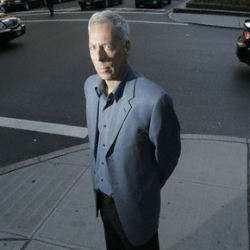
An interview with documentary filmmaker Marc Levin about Brooklyn Babylon and the Toronto Jewish Film Festival
As I rushed into a crammed TTC subway car on a usual rush-hour morning a few weeks ago, a really interesting ad poster caught my attention. It was an image of a black man wearing the characteristic black hat and long curly hair locks (payos) of the Hasidic Jews. The caption accompanying this most unusual image was “Find your inner Jew.” It was one of a series of similar culture-transcending ingenious ads for the annual Toronto Jewish Film Festival. As I waited for my next stop, I was intrigued. Would Blacks really feel a strong enough connection to take the time to take that challenge of finding their inner Jew? What is the connection anyway?
The history buff in me had me thinking about the Ethiopian Jews, the Falashas, who have a very ancient Judaic tradition. There is a strong belief among the Falashas that they hold to this day the genuine biblical Ark of the Covenant. It is said to be hidden inside The Chapel of Saint Mary of Zion in Axum, Ethiopia (in Tigray Province). Tradition holds that Menelik I, the founder of a three-thousand-year-long Solomonic dynasty of Ethiopian kings, was the offspring of a union between the biblical King Solomon and the Queen of Sheba (Makeda). As it is widely known, Rastafarians hold this historical narrative as the bedrock of their belief system. The conquering Lion of Judah represents a major symbol of this tradition.
So, the leap between Hasidic Jews and Rastafarians may not be so huge after all. As one commentator astutely quipped, “In Brooklyn, Hasidic Jews and Rastafarians share a taste for certain things: hats, unusual hairstyles, and the Old Testament.”
Speaking actually directly from Brooklyn, New York, last week as part of an exclusive AfroToronto.com interview with Marc Levin, one of the directors of one of the films shown at this year’s Toronto Jewish Film Festival, I attempted to dig deeper into this ancient relationship between Blacks and Jews. Marc Levin’s film in question was Brooklyn Babylon (2001). Set in the wake of 1991’s infamous Crown Heights riots between Jews and African-Americans, Brooklyn Babylon depicts a romance between an Orthodox Jewish girl (Karen Goberman) and a Rastafarian musician Sol (played by Tariq Trotter of the group The Roots).
Who can be down?
Primarily a documentary filmmaker, Marc Levin has never been afraid to tackle controversial subjects. His 1998 film Slam (which won both the Grand Jury Price at Sundance and the Camera d’Or at Cannes) is the tale of a gifted Black rapper and spoken word artist (Saul Williams) who finds himself behind bars in Washington D.C. under drug charges. He clings to the power of words to make it through his ordeal. But a middle-aged, White, Jewish filmmaker, Marc Levin, claims that he has never set out to make a Black film per se with Slam. He was working at the time on a documentary in Washington D.C. about the striking reality of an entire generation of young Black men caught in the revolving door of the U.S. capital’s prison system. Slam was born out of that journey into this harsh world.
With the critical success of his cult film Slam, Marc Levin tells AfroToronto that “many people assumed that I was Black. When they (Slam’s fans) saw me, they were kind of stunned. ” His next film after that, White BoysWhite Boys, Levin chronicles the story of a White teenage kid in the cornfields of Iowa who fantasizes about becoming a Black gangsta rapper. Calling himself, Flip Dogg, he and his farm-bred friends convince themselves that they are genuine drug-dealing brothas in their mid-western hood. Interestingly enough, last week’s Toronto screening of Brooklyn Babylon was preceded by a short film which likewise examines the twists and turns of a musical and cultural clash and the ultimate meddling of heritage. The film featured the increasingly popular Hasidic reggae artist Matisyahu. Born in West Chester, Pennsylvania (as Matthew Miller), he grew up as a secular Jew who enjoyed hip hop and also followed bands like Dead-Head and Phish. Following a fateful trip to Israel, he became a religious Jew and simultaneously discovered his love for reggae music. The result has been a perhaps surprisingly coherent and authentic sound mixing the best of Yiddish music, hip-hop, dancehall and reggae. (1999) was, according to Levin, in a way, an attempt to answer those people’s question of “How did you make this film?” In
| Again, we find a link between Rastafarianism and Judaism. Marc Levin himself recounts his journey of discovery during his first trip to Jamaica back in the 1970s. He credits the Rastafarians with turning him on to the biblical psalm of psalms. He found that the tradition of Solomon and the Queen of Sheba was equally strong among the Rastafarians and Ethiopians as it was among Jewish mystic culture. He marvels at how, In Brooklyn, you don’t even need to go to Jamaica or Israel to experience these cultures because “they intermingle right here in Eastern Parkway.”
Brotherhood or exploitation? But despite whatever similarities there may be between Blacks and Jews, it is undeniable that the relationship has not necessarily always been rosy. The relatively recent Crown Heights riots in New York in 1991 is just one example. |
 |
The exploitation factor in the relationship between Blacks and Jews was a major topic in a panel discussion held at Bloor and Spadina’s Jewish Community Centre last week as part of the Toronto Jewish Film Festival’s Rhythm and Jews series exploring the Black-Jewish musical connection. The culturally balanced panel, which included, among others, local Black radio host Norman Otis Richmond and Jewish author and scholar Jeffrey Melnick, was a most interesting and sometimes heated exchange of ideas. For instance, while Norman Otis Richmond sought to praise Clive Davis as a great producer, he also wanted to make clear his view that Duke Ellington’s manager, Irving Mills, was a naked exploiter. But the Jewish moderator made the point that Louis Armstrong had been adopted at a very young age by a Jewish family that bought him his first trumpet.
During his conversation with AfroToronto.com, Marc Levin and I also discussed what he calls: “the classic example of the Jewish businessman ripping off the Black artist.” Levin admitted that there is always going to be some exploitation factor between any management and their artists. But he takes the example of Russell Simmons and P. Diddy going into the fashion industry in a major way, then asking the question: “Are they ripping off the market share traditionally of Jewish garment industry workers?” I am not sure if this is necessarily a very potent argument since, at some level, it fails to take into account the collective power of each community in the grand scheme of things. As Levin himself points out, Jews and Blacks had originally lived together in New York because “nobody else wanted to live with either of us.” But, as Levin also acknowledges, the post Second World War era ushered a great era of wealth amongst the Jewish community as a whole. This, in turn, led to what we can call the “suburbanization effect,” which saw the Jews leave their old neighbourhoods where they cohabited with Blacks to move into affluent White neighbourhoods. According to Marc Levin, this was the beginning of the deterioration of the Black-Jewish relationship and their original kinship through the story of Exodus’ themes of exclusion and slavery that can be found in the Negro Spirituals.
However, as the panel of the Rhythm and Jews series concluded, there is a lot to celebrate in terms of historically fruitful collaborations between Blacks and Jews. As long as we are honest about the shortcomings of this relationship and recognize how moving forward in brotherhood benefits us all, we can continue to make beautiful music together like the duo The Afro-Semitic Experience did last week at the end of the panel discussion.

